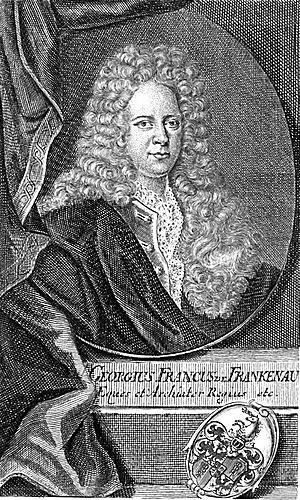Georg Franck von Franckenau facts for kids
Georg Franck von Franckenau was a smart German doctor and plant expert. He was born on May 3, 1643, in a town called Naumburg in Germany. He passed away on June 17, 1704, in Copenhagen, Denmark.
Contents
Georg Franck's Early Life and Studies
Georg Franck was very dedicated to learning. He studied medicine and anatomy in a city called Strasbourg. Anatomy is the study of the body's structure. He earned his medical degree, called an M.D., in 1666.
Becoming a Professor and Royal Doctor
After his studies, Georg Franck taught important subjects. He taught anatomy, chemistry, and botany in Jena. Botany is the study of plants. In 1679, he became a Professor of Medicine at the University of Heidelberg.
He also became a personal doctor to important leaders. These included the Margrave of Baden, the Duke of Württemberg, and the Archbishop of Trier. Being a personal physician meant he was their trusted doctor.
Moving Due to War and Royal Recognition
Life in Heidelberg became difficult because of a war. This was the War of the Palatinate Succession. Due to a French invasion, he had to leave Heidelberg. He moved first to Frankfurt and then to the University of Wittenberg.
Georg Franck received special honors for his work. In 1692, he was knighted by Leopold I, Holy Roman Emperor. This was a very high honor. A year later, on November 30, 1693, he became a Fellow of the Royal Society. This is a group of very smart scientists.
Later, he moved to Denmark. He became the personal doctor for King Christian V in Copenhagen. He lived there until he passed away on June 17, 1704.
Georg Franck's Important Works
Georg Franck wrote several important books. His writings showed his knowledge of both plants and old traditions.
- Flora Francica Aucta, oder vollständiges Kräuter-Lexicon,… (1680): This book was like a complete dictionary of plants. It focused on the plants found in a region of Germany called the Palatinate.
- Disputatione ordinaria disquirens de ovis paschalibus / von Oster-Eyern (1682): In this work, he wrote about Easter eggs and the Easter Hare. This shows his interest in cultural traditions.


